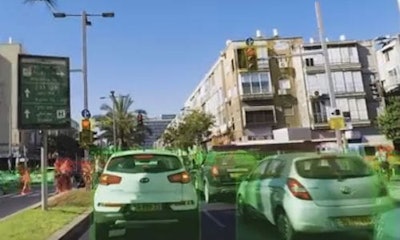
A representation of how Cortica's AI sees the world. Cars are in green, pedestrians in red. Cortica's system takes in all the data from the sensors, processes the images, clusters them and tags them with data that has already been defined.
By Jeff Sanford
Toronto, Ontario — July 16, 2017 — In this week’s Autonomous Report, we take a look at the enormous amount of venture capital being poured into autonomous vehicles (AVs) and why most of it will be lost, what your self-driving cars sees as it learns how to drive, a vision of the future that will see cars transformed into “transportation experience pods” and much, much more!
– As the Autonomous Report has noted several times in recent weeks, the software that is turning out to be the most successful for AVs are so-called learning-based programs. The industry had been using rules-based software in earlier attempts to build an AV. It turns out that approach doesn’t work. There are too many different situations in real-world driving to be able to program a rule for every situation.
Instead, learning-based approaches allow a car to figure out how to drive by referencing vast numbers of scenarios and experiences. Once enough “experience” is gained the cars seem better able to handle day-to-day driving. To this end various companies are coming up with ways to generate the experience AVs need to learn how to drive. Google is thought to be in front on this, as its cars have logged millions of miles of test driving. Other companies are offering software-based approaches to learning.
A company called Cortica was mentioned in an article this week on Tech Crunch on the occasion of its opening of an automotive division to make use of its AI software. According to the report, the key to making a good AV is the, “… use of unsupervised learning that allows an autonomous system to process data and figure out its environment.” The article goes on to claim that, “… supervised machine learning is when the AI is given a set of examples and what they mean so that it can learn to recognize similar items in the future. For example, you could feed the system a thousand images of stop signs—some faded, some obscured by tree branches, etc.—so that the AI can learn to recognize stop signs.”
Going further, “In unsupervised machine learning, the examples aren’t labelled. The AI has to classify and organize the examples based on common characteristics. Stop signs, for example, are red with white borders and eight sides. The AI can learn as it goes that sometimes that red is faded and sometimes a white border will be obscured by a tree branch, but it can make changes as needed to classify stop signs as stop signs.”
To facilitate the learning process, Cortica developed a system that takes, “… in all the data from the sensors, processes the images, clusters them, and tags them with meta-data that has already been defined.” The AI then navigates through the environment learning how these different objects exist in the real world. You can check out a video from Cortica that shows how the system works in the player below.
– An interesting article in the Financial Times notes that a huge new, “… wave of venture capital focused on the car technology sector is sweeping across Silicon Valley. It’s starting to feel a bit like the old dot-com boom days of the late 1990s. According to the report, just this week alone $220 million in new funding has been announced. This is after an “all-time high” of $1.6 billion was invested through the first half of this year. Clearly, “… the advent of autonomous vehicles has fuelled a rush by carmakers and venture firms to invest in transportation technologies.”
According to the report, “… a growing number of specialized venture funds dedicating themselves to car technology—a field that spans everything from machine learning and mapping, to logistics and parking services …”
It seems strategies in approach are already beginning to diverge. According to the Financial Times, “One camp of investors is more focused on transportation services viable in the near-term, while the other is betting on a utopian vision of fully self-driving vehicles.”
These two approaches provide some clues as to the timelines around the introduction of AVs. According to a quote from one of the shorter-term investors, “We have to think about how to make money in the next 10 years, and in our view, full Level Five autonomous vehicles and flying cars is more than that 10-year horizon. We don’t want to invest in a company whose success is predicated on full adoption of autonomous. We probably gravitate more toward the realist end of the spectrum, rather than the mega-moon shot end of the spectrum.”
Funds such as AutoTech have attracted investors such as car component maker Borg Warner, car dealership groups, trucking groups and car repair companies, according to the report. The story also notes that, “The Toyota Research Institute launched a $100 million artificial intelligence fund on Tuesday, called Toyota AI Ventures, which will invest in early stage start-ups working on technologies relevant to autonomous driving and robotics.”
– Bloomberg also reported on the new investment gold rush occurring around AVs, noting that, “The race to field the first autonomous car will be a Darwinian exercise, with more than 50 major competitors reduced to a handful of winners over the next decade, according to a new study by consultant AlixPartners.”
That is, just like the dot-com boom or the early birth of the automotive industry, a massive number of new players will enter the space. The vast majority will fail. Billions of dollars will be lost by venture investors. Only a few will survive and win.
“You’ve got 50 major players trying to develop autonomous software and you’ll probably get three or four of them who will win,” says John Hoffecker of AlixPartners, according to the Bloomberg report. “There will be billions and billions of dollars lost in bets that were put in the wrong place.”
According to the story, “Last year alone, 195 partnerships were formed to create autonomous, connected, shared and electric vehicles … More than 200 players have come from outside the auto industry to get in the game, many from Silicon Valley.” According to Hoffecker, “The number of people who will succeed in autonomous in the future is going to be a handful. So you’re going to find 90 percent of the investments, where people are spending tens and hundreds of millions-plus, will be completely thrown away.”
Thankfully there are really rich investors willing to take the risk. This is how the internet got built without spending huge amounts of tax money from the government. A bunch of rich people bet money to achieve a really big payoff. Most lost money, but the few that made insane amounts continue to provide hope to the venture capital community.
– A report, Intel Predicts Autonomous Driving Will Spur New ‘Passenger Economy’ Worth US$7 Trillion, lays out some interesting ideas. For one, the report introduces a new phrase: The Passenger Economy. In the AV world, as humans leave the driving to computers, the average person is going to have a lot of new free time. The entrepreneurial-minded are already thinking about the “opportunity streams” this new world will offer.
According to the report, “… from onboard beauty salons to touch-screen tables for remote collaboration, fast-casual dining, remote vending, mobile healthcare clinics and treatment pods, vehicles will become transportation experience pods.” The interior of vehicles will feature “movable movies.” According to the report, “Media and content producers will develop custom content formats to match short and long travel times.” Passengers can also look forward to location-based advertising, which, “… will become more keenly relevant, and advertisers and agencies will be presented with a new realm of possibilities for presenting content brands and location.”
Another new concept in the report: Mobility-as-a-Perk, or MaaS. According to the report, “Employers, office buildings, apartment complexes, university campuses and housing estates will offer MaaS to add value to and distinguish their offer from competitors or as part of their compensation package.”
– A story appearing on The Drive was subtitled, “Those autonomous parking garages can’t come soon enough.” The piece goes on to tally up the “billions” of dollars drivers spend searching for parking spots and paying for them. According to data in the report, “In the US alone, motorists are wasting 17 hours and a shocking cost of $72.7 billion per year on parking … the US city that suffers the most is New York City where motorists spend 107 hours per year looking for a spot.” AV supporters envision a future world in which passengers will be dropped off at their destination while the car parks itself, freeing up that 17 hours.
– A story on MediaPost notes that Starship Technologies announced this week that it has, “… now has received permission to allow the six-wheeled delivery robots in Ohio. The state joins Florida, Idaho, Wisconsin and Virginia in opening the door to the nearly two-foot high robots to travel the sidewalks as they make their way to recipients.”
The delivery robots Starship Technologies is building can, “… travel up to 10 miles an hour, but generally are set to travel at around four miles an hour, and they run primarily on sidewalks.” An interesting note in the story flicks to the legal definitions contained in the Ohio state budget that approved the sidewalk delivery robots. According to the report the bill defines pedestrians and drivers as such: “Pedestrian means any natural person afoot. Pedestrian includes a personal delivery device. Driver or operator means every person who drives or is in actual physical control of a vehicle, trackless trolley or streetcar.” The story also notes that robots have already, “… delivered food and pizza in Germany [and] cupcakes in California …” Starship executives predict the company will be delivering pizzas in Ohio within the year. To ensure no one trips over one of the cooler-sized bots the vehicles have nine cameras and an orange flag with LEDs on it.























